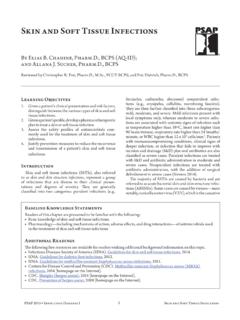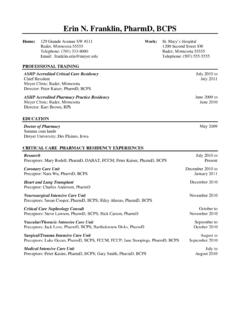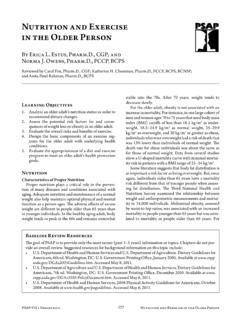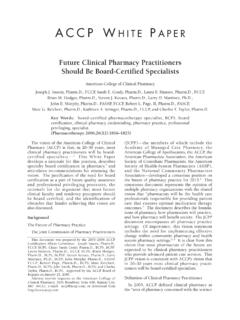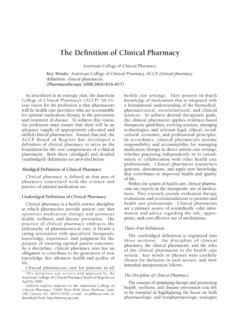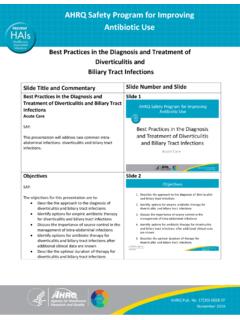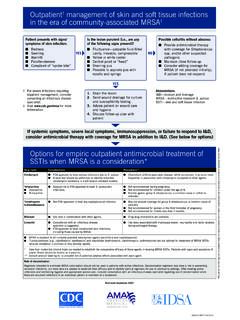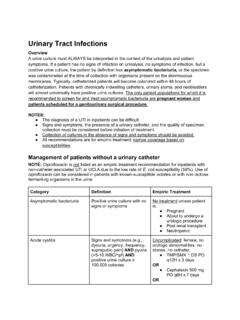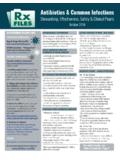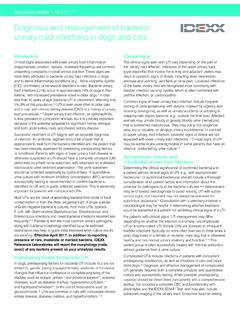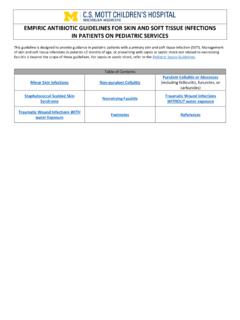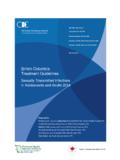Transcription of Urinary Tract Infections - ACCP
1 7 PSAP 2018 BOOK 1 Infectious DiseasesUrinary Tract InfectionsIntroductIonAccording to the CDC, UTIs are the most common bacterial infection requiring medical care, resulting in million ambulatory care visits in 2007, 23% of which occurred in the ED (CDC 2011). Over million patients in the United States visited the ED for the treatment of UTIs between 2006 and 2009 and million patients ( ) were admit-ted to acute care hospitals (Sammon 2014). The economic burden of using the ED for the treatment of UTIs is estimated at $2 billion annu-ally.
2 In addition, UTIs rank as the No. 1 infection that leads to an anti-biotic prescription after a physician s visit (Abbo 2014).Catheter-associated UTIs (CA-UTIs) are the most common type of health care associated Infections reported to the National Health-care Safety Network, making up two-thirds of hospital-acquired UTIs (CDC 2017). The symptoms of UTIs are generally mild, and inappro-priate use of antibiotics can lead to antibiotic resistance; therefore, it is important to establish the appropriate criteria for treatment using narrow-spectrum antibiotics for the optimal Up to 60% of women have at least one symptomatic UTI during their lifetime.
3 Around 10% of women in the United States have one or more episodes of symptomatic UTIs each year. Young, sexu-ally active women 18 24 years of age have the highest incidence of UTIs. About 25% of these women have spontaneous resolution of symptoms, and an equal number become infected (Sobel 2014). The prevalence of UTIs in men is significantly lower than in women, occurring primarily in men with urologic structural abnormalities and in older adult In thIs chApterABP Acute bacterial prostatitisASB Asymptomatic bacteriuriaCA-UTI Catheter-associated Urinary Tract infectionCBP Chronic bacterial prostatitisCRE Carbapenem-resistant EnterobacteriaceaeESBL Extended-spectrum -lactamaseIDSA Infectious Diseases Society of AmericaKPC K.
4 Pneumoniae carbapenemaseMDR Multidrug-resistantNDM New Delhi metallo- -lactamaseSNF Skilled nursing facilityTable of other common Analyze patient risk factors and examination data to distinguish different types of Design an appropriate empiric treatment plan according to the type and severity of UTI for a patient presenting in the inpatient or outpatient Justify pharmacotherapy management for special patient populations with asymptomatic Evaluate the role of antimicrobial and non-antimicrobial strategies for the prevention of recurrent by Vanthida Huang, , FCCP; Wasim S.
5 El Nekidy, , BCPS, BCACP; LaDonna M. Oelschlaeger, , BCPS; Mary L. Foss, , MBA, BCPS; and Gabriella Douglass, , BCACP, AAHIVP, BC-ADMBy Helen S. Lee, , BCPS-AQ ID; and Jennifer Le, , , FIDSA, FCCP, FCSHP, BCPS-AQ IDUrinary Tract InfectionsLEarnIng ObjEcTI vEs 722/12/17 5:15 PMPSAP 2018 BOOK 1 Infectious Diseases8 Urinary Tract InfectionsPathophysiology Lower UTIs, also known as cystitis, are significantly more prevalent in women than in men. This is primarily because of anatomic differences, including shorter urethral length and moist periurethral environment in women.
6 Urinary Tract Infections typically start with periurethral contamination by a uropathogen residing in the gut, followed by colonization of the urethra and, finally, migration by the flagella and pili of the pathogen to the bladder or kidney. Bacterial adherence to the uroepithelium is key in the pathogenesis of UTI. Infec-tions occur when bacterial virulence mechanisms overcome efficient host defense UTIs, also known as pyelonephritis, develop when uropathogens ascend to the kidneys by the ureters.
7 Infec-tions can occur when bacteria bind to a Urinary catheter, a kidney, or a bladder stone or when they are retained in the uri-nary Tract by a physical obstruction. In severe cases of pyelo-nephritis, the affected kidney may be enlarged, with raised abscesses on the surface (as revealed in imaging studies). Staphylococcus aureus bacteremia or endocarditis can lead to hematogenous seeding of the bacteria to the kidneys, caus-ing suppurative necrosis or abscess formation within the renal parenchyma (Sobel 2014).
8 In contrast, gram-negative bacilli rarely cause kidney infection by the hematogenous route. According to an experimental model of pyelonephritis, the main renal abnormality reported is the inability to maxi-mally concentrate the urine (Sobel 2014). This concentration defect occurs early in the infection and is rapidly reversible with antibiotic therapy. An obstruction can lead to progres-sive destruction of the affected kidney and subsequent renal Factors In the non-pregnant adult woman with a normal Urinary Tract , bacteriuria infrequently progresses to symptomatic cystitis or pyelonephritis.
9 common predisposing factors for UTIs are listed in Table 1-1. The urethra is usually colonized with bacte-ria, and sexual intercourse can force bacteria into the female bladder. Furthermore, spermicides increase colonization of the vagina with uropathogens and adherence of Escherichia coli to vaginal epithelial with structural abnormalities develop UTIs largely from obstruction of the urine flow. Urinary stasis increases susceptibility to infection. Men of any age and pregnant women are susceptible to lesions that result in obstruction (Sobel 2014).
10 Typical causative Organisms and antibiotic resistance Urinary Tract Infections are primarily caused by gram-negative bacteria, but gram-positive pathogens may also be involved. More than 95% of uncomplicated UTIs are monobacterial. The most common pathogen for uncomplicated UTIs is E. coli (75% 95%), followed by Klebsiella pneumoniae, Staphylococcus saprophyticus, Enterococcus faecalis, group B streptococci, and Proteus mirabilis (Sobel 2014). Distribution of uropatho-gens may differ by type of infection or patient population (Table 1-2).

